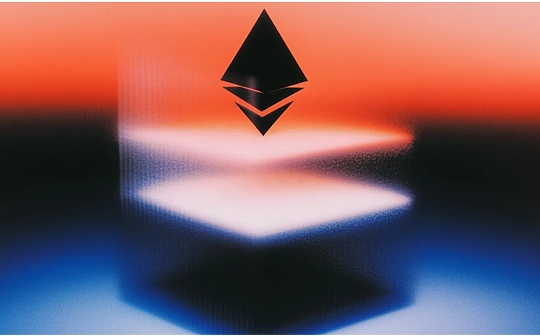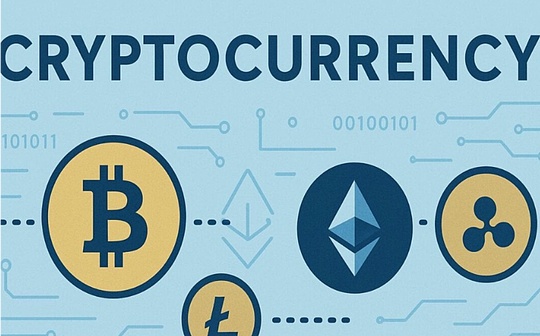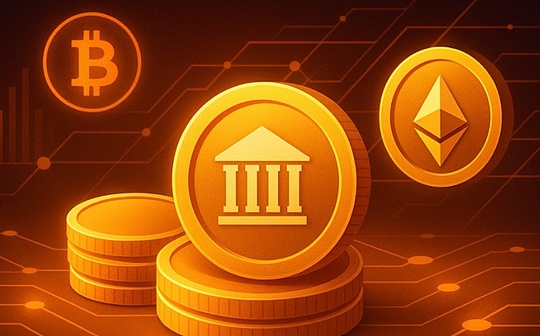
Author Tanay Ved & Victor Ramirez, Source: Coin Metrics, Compiled by: Shaw Bitchain Vision
Important points
-
Kraken, Gemini and Bullish are preparing to go public in a favorable regulatory environment and investors’ interest in open market investment.
-
Coinbase set a benchmark for its initial public offering (IPO) in 2021, with a market value of $65 billion when it went public.At that time, 96% of its revenue came from transaction fees, while subscription and service revenue had accounted for 44% as of the second quarter of 2025.
-
Of these exchanges, Coinbase leads with a spot trading volume of 49%.Bullish and Kraken each account for 22% and are rapidly expanding new businesses.
-
Not all reported transaction volumes have equal value.Round trip trading analysis highlights the over-stated trading activity on some platforms and emphasizes the need to assess exchange quality and transparency.
Introduction
Since the existence of the cryptocurrency industry, successive US governments have either been indifferent or hostile to the cryptocurrency industry.But there was a constructive shift last week.
The White House Digital Assets Working Group released a 166-page report that outlines the current status of digital assets and proposes policy recommendations for establishing a comprehensive market structure.Meanwhile, the U.S. Securities and Exchange Commission (SEC) chairman Paul Atkins introduced the agency’s Project Crypto program in a public speech.The plan aims to make the United States a “cryptocurrency capital” by introducing financial markets into blockchain, simplifying the cumbersome licensing structure of crypto businesses, and promoting the creation of financial “super applications” that provide a wide range of services.
The main beneficiary of this new regulatory system is centralized exchanges.Several private centralized exchange businesses such as Kraken, Bullish and Gemini are seizing this relatively favorable environment to seek an initial public offering (IPO).As these companies open to the public, it is crucial for investors to understand their underlying drivers.In this article, we will dissect key metrics for evaluating these exchanges and point out some notes for using exchange-reported data.
Crypto exchanges’ IPO boom
After Coinbase completed its initial public offering (IPO) in April 2021, crypto-related IPOs have stalled over the past four years (in largely due to hostile relations between cryptocurrency companies and the previous SEC).As a result, private companies cannot obtain liquidity from the open market, and non-qualified investors cannot benefit from investing in these businesses.A new group of private cryptocurrency companies have announced their intentions to go public as the Trump administration promises a more friendly regulatory system.
This environment, coupled with a new desire for open market exposure, has spawned some of the most explosive IPOs, such as the recent listing of Circle.Gemini, Bullish and Kraken are also considering listing in the U.S., hoping to take advantage of this open window to position themselves as full-stack providers of digital assets.
Coinbase IPO in 2021
Coinbase’s initial public offering (IPO) in 2021 provides a useful benchmark for evaluating the investment prospects of potential exchange IPOs.The company was listed directly on Nasdaq on April 14, 2021 with a reference price of $250 per share, meaning a fully diluted valuation of $65 billion and an opening price of $381.Coinbase’s listing is at the high of the 2021 bull market, when Bitcoin trading near $64,000 and exchange trading volume exceeds $10 billion.
As outlined in its S-1 application documents, Coinbase’s business model was simple at the time, with the vast majority of its revenue coming from facilitating transactions:
“We have grossed over $3.4 billion since its inception and December 31, 2020, with most of this coming from transaction fees generated by retail investors and institutions based on transaction volume on our platform. For the fiscal year ended December 31, 2020, trading revenue accounted for more than 96% of our net income. We leverage the advantages of our trading business to expand and expand our platform by investing in our “flywheel”, launching new products and services, and developing the ecosystem.”
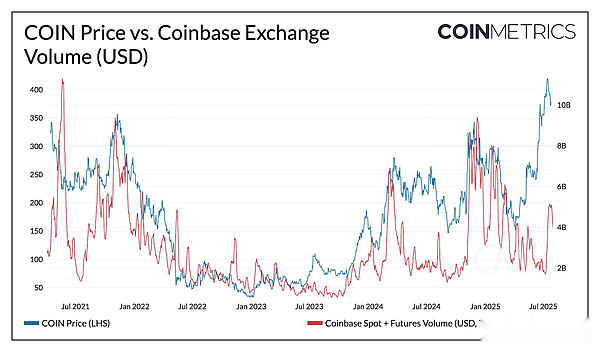
Source: Coin Metrics Market Data Pro and Google Finance
Today, Coinbase looks more like a “full business exchange.”Although transactions are still the core of its operations, its business model has significantly expanded to the entire chain of cryptocurrency services.This change began to be reflected in the relationship between stock prices and exchange trading volume, which in the early stages were closely related.
However, this correlation has weakened as the correlation between “subscription and service income” composed of stablecoin income (USDC interest income), blockchain rewards (staking), and custodial income is increasing:
Coinbase Q1 2021
-
Revenue $1.6 billion
-
USD 1.55 billion (96%) transaction revenue
-
$56 million (4%)Subscription and service revenue
Coinbase Q2 2025
-
Revenue $1.5 billion
-
764 million (51%) transaction revenue
-
656 million (44%) subscription and service revenue
-
77 million (5%) corporate equity
Comparative study on IPOs on the upcoming exchanges
Based on this framework, we list the estimated valuations, trading volume and business sectors of upcoming exchanges.
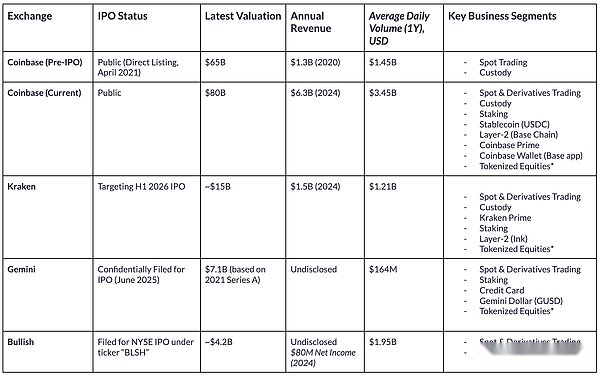
Source: Coin Metrics Market Data Pro and public company documents (data as of August 1, 2025)
Although the services provided by these exchanges are converging, they still have significant differences in market share and transaction size.
Since its launch in 2013, Kraken appears to have reached a higher stage of maturity.The company’s financial growth was strong, with revenue of $1.5 billion in 2024 (128% increase from 2023) and revenue of $412 million in the second quarter of 2025.Kraken also made a strategic expansion, acquired NinjaTrader, obtained a European MiCA license, and is expanding its tokenized stock, payments and on-chain infrastructure (Ink) businesses.Based on a target valuation of about $15 billion and a revenue of $1.5 billion in 2024, Kraken has a 10x P/E ratio, slightly below Coinbase’s 12.7x.
By contrast, Gemini has a smaller operating scale.Its average trading volume over the past year was $164 million, the lowest among these exchanges.Gemini’s most recent valuation was $7.1 billion in 2021’s Series A financing, while private equity markets valued it at $8 billion.In addition to the spot and derivatives business, Gemini also offers pledge and credit card products that provide income for users’ deposits and is the issuer of Gemini USD (GUSD), whose circulating supply has dropped to 54 million.
Bullish has averaged nearly $1.95 billion in trading volume over the past year, ranking among the top in trading activity.The exchange is at the heart of its trading and liquidity infrastructure, and as an institutional key exchange, it is regulated in Germany, Hong Kong, China and Gibraltar, while actively seeking US licenses.In addition, Bullish has expanded the information services field through its acquisition of CoinDesk.In the F-1 filing, the company disclosed that it achieved a net profit of $80 million and a net loss of $349 million in 2024.Originally based on a SPAC deal that was cancelled in 2022, valued at nearly $9 billion, Bullish is now allegedly seeking a $4.2 billion valuation.
Trading volume trends on each exchange
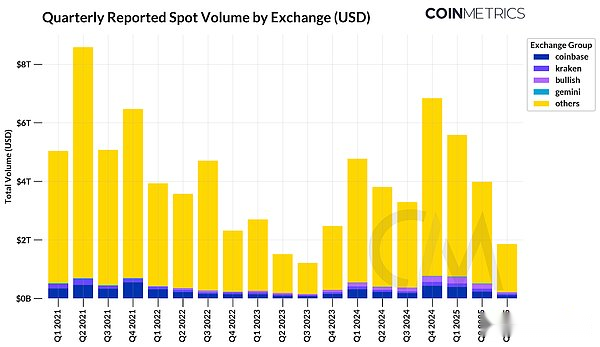
Source: Coin Metrics Market Data Pro
Overall, Coinbase and other exchanges preparing to go public account for only about 11.6% of the reported spot trading volume on trusted centralized exchanges.Binance alone accounts for 39%, while other offshore exchanges also account for a large share.Coinbase accounts for 49% of spot trading volumes for the exchanges of interest alone, followed by Bullish and Kraken, each accounting for 22%.Bullish’s share has steadily risen since its launch in 2022, while Kraken’s share has shrunk as competition intensifies.
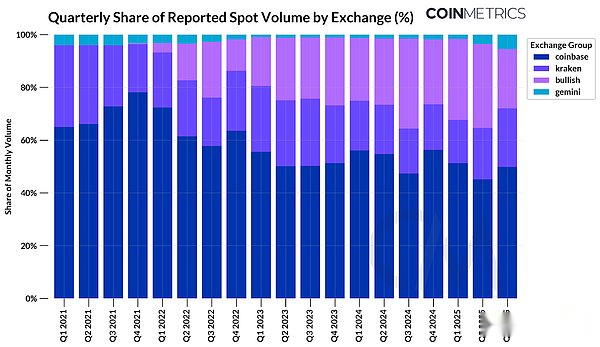
Source: Coin Metrics Market Data Pro
Review of the economic activities of each exchange
As we have seen above, trading volume is one of the most predictive indicators for estimating valuations.But the reported trading volume can be misleading due to the exchange.
Although most mainstream cryptocurrency exchanges have cracked down on wash trading, there are still some “outlaws” that exist.Our Trusted Exchange Framework methodology details how to detect abnormal trading activity and the assessment of qualitative factors such as regulatory compliance.
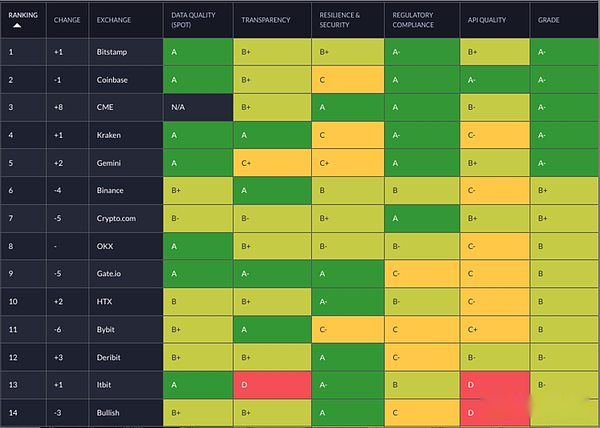
source: Trusted Exchange Framework
We have developed a more efficient signal to detect false transactions, which is to calculate the frequency of round-trip transactions.Our test method is as follows:
-
We randomly selected 144 5-minute periods from January to June 2025, covering nearly 20 million transactions.
-
For each exchange and time period, select a transaction.
-
If a transaction that is opposite to the previous transaction, with an amount that is nearly the same (Error less than 1%) and a price that is almost the same (Error less than 1%) within 10 transactions or within 5 seconds, both transactions are marked as round trip transactions.
-
Repeat the above for each transaction.If the transaction has been marked as a round trip transaction, skip.
-
Calculate the volume marked as a round trip transaction and divide it by the total volume.
In the figure below, we draw the transaction samples selected from a few exchanges in a specific time period, marking out which transactions are suspected to be round trip transactions.Each gray dot represents a normal transaction, and each green and red mark represents a round trip transaction.
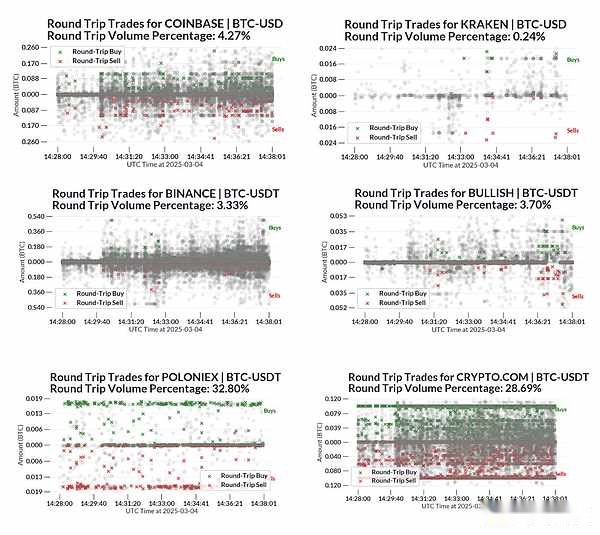
source: Trusted Exchange Framework
Because of the approximate nature of this approach, we expect some false positive round trip transactions that are the result of normal market activity (e.g., market makers facilitate transactions by providing liquidity between buyers and sellers of the order book).However, the high percentage of round trip transactions is concerned about the reliability of their reported volume data relative to the industry benchmarks shown by Crypto.com and Poloniex.
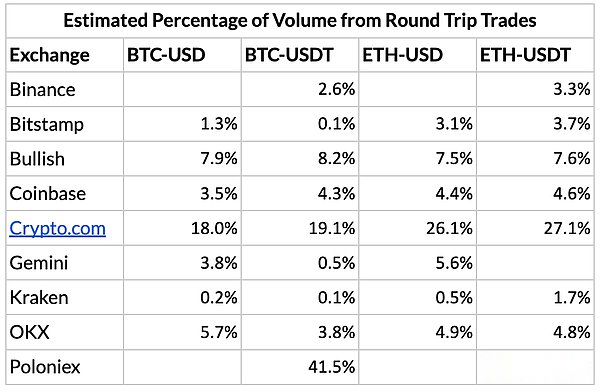
Specifically: From the first and second quarters of 2025, we estimate Crypto.com transaction volumes to be approximately $720 billion, including BTC-USD ($201 billion), BTC-USDT ($192 billion), ETH-USD ($165 billion) and ETH-USDT ($160 billion).Based on the estimated percentage above, we estimate that $160 billion of transactions in these pairs are from round trip transactions.
in conclusion
With several cryptocurrency exchanges coming soon, it is in their best interest to investors understand the relative pros and cons of these trading platforms.Although trading volume helps estimate transaction revenue (which is still the main source of revenue), qualitative factors such as business diversification, whether there are self-transactions and compliance are also important considerations in evaluating exchange quality.These factors can help market participants determine whether the valuation is reasonable.
Coinbase remains the leader after four years of its IPO, thanks in large part to its successful diversification of revenue sources to areas such as custody, stablecoins and Layer 2 network fees.However, competition in the exchange market is intensifying.If other exchanges want to compete, they must expand their revenue sources beyond transaction-related fees, because transaction-related fees are highly correlated with market sentiment and are highly cyclical.As the market structure gradually becomes clear, exchanges are being allowed to transform from a simple trading venue to a full range of super applications.How these exchanges seize this opportunity, whether they can realize their vision and achieve success comparable to those breakthrough IPOs in the past will be good news to watch next year.




